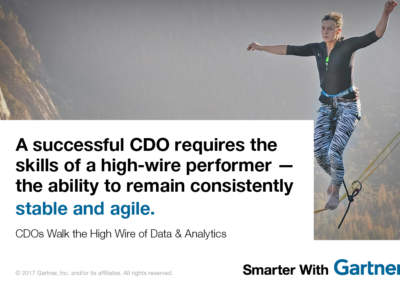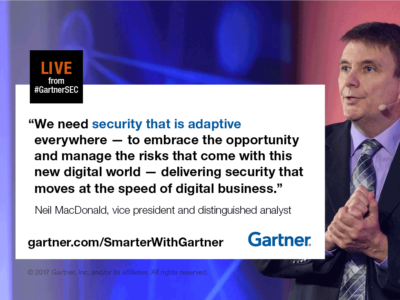For chief data officers, establishing a data-driven culture is more a matter of influence than control.
As the person at the forefront of an organization’s shift to data-driven business, the chief data officer (CDO) is expected to influence its culture — to make it more data-driven in its decision making, in its operations, and in the behavior of its people.
“Influencing culture change requires the CDO to engage with stakeholders at a human level,” said Alan Duncan, research director at Gartner. “She or he must take into account the overall desires and motivations of the organization, the potential impacts on the circumstances of individuals, and understand the broader expectations of the wider ecosystem.”
To further a shift to a data-driven business culture, the CDO must show leadership in three key areas of influence: business value, cultural change and ethics.
Identify and Communicate the Business Value of Data
Typically, a business’s demand for data is communicated far more clearly than are the business outcomes that result from analysis of that data. This represents a substantial opportunity for CDOs to identify and communicate the business value of data.
CDOs should set investment objectives based on the improved business outcomes that derive from increased customer engagement and the use of optimized analytics and expanded business models and ecosystems.
To identify and communicate the business value of data, CDOs can:
- Measure the value of information assets.
- Establish and maintain an information catalog.
- Act as a catalyst for changes to the business model.
Address the Cultural Change Impacts of a Data-Driven Approach
A business’s culture is founded on its people’s deep-seated beliefs and emotions, so CDOs cannot simply demand that workers “change their culture.” Instead, CDOs must persuade them that cultural change is necessary, and help them construct and internalize an alternative belief system that produces a new set of behaviors.
“Trying to implement new behaviors and measurements without addressing the underlying culture is counterproductive — it results in even well-intentioned people slipping back into old, undesirable behaviors during times of pressure and uncertainty,” said Mr. Duncan. “As something members of the organization must do collectively, substantive business transformation begins with culture, and culture begins with a shared language for how information is managed and used.”
CDOs can influence cultural change by taking the following actions to facilitate development of this shared language:
- Be explicit about how data influences different styles of decision making.
- Be clear about how stakeholders engage with data.
- Articulate the measurable business outcomes of data and analytics initiatives.
- Communicate how data influences working practices.
Manage the Ethical Implications of Data and Analytics
Business decision making can have far-reaching implications, including highly detrimental consequences. CDOs must take the lead in ensuring any ethical considerations regarding data and analytics are addressed.
They should:
- Establish a code of conduct for data and analytics.
- Balance business benefits with potential privacy risks.
- Design analytics with trust in mind.
Get Smarter
Client Research
Additional information is available to Gartner clients in the report “How Chief Data Officers Show Leadership in Influencing the Data-Driven Culture.”
Event
Gartner analysts will provide additional analysis and information on the outlook for data and analytics at the Gartner Business Intelligence & Analytics Summit 2016, October 10-11 in Munich, Germany. You can follow news and updates from the events on Twitter using #GartnerBI.
Source: gartner.com/smarterwithgartner











